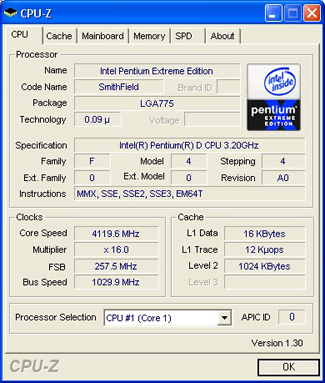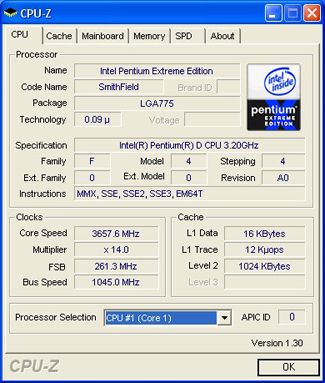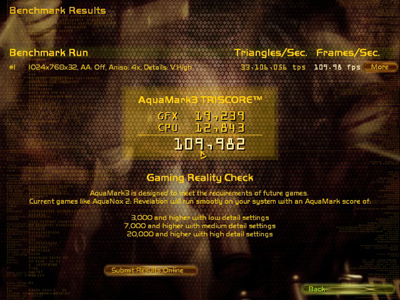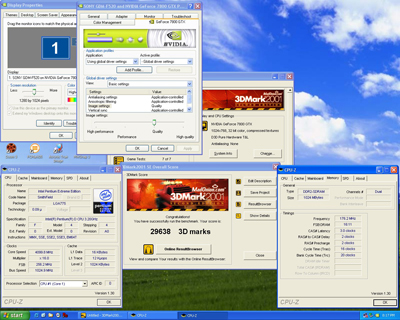Asus P5N32-SLI: Dual x16 - What Dreams Are Made On . . .
by Gary Key on October 27, 2005 12:05 AM EST- Posted in
- Motherboards
ASUS P5N32-SLI Deluxe: Overclocking
FSB Overclocking Results
Memory Stress Testing
Memory stress tests look at the ability of the Asus P5N32-SLI Deluxe to operate at the officially supported memory frequencies of 667MHz DDR2 at the best performing memory timings that the Corsair CM2X512A-5400UL revision 1.3 will support.
The Asus P5N32-SLI Deluxe was completely stable with 2 DDR2 modules in Dual-Channel at the settings of 3-2-2-8 at 2.1V and was stable at this setting up to a timing mode of 720MHz before changing the Command Rate to 2.
We will now install all four available memory slots, which are usually more strenuous on the memory subsystem than testing 2 DDR2 modules on a motherboard.
The Asus P5N32-SLI Deluxe was completely stable with 4 DDR2 modules in Dual-Channel at the settings of 3-2-2-8 and only needed the voltage increased to 2.2. This is an excellent accomplishment and truly shows off the engineering aspects of this board.
FSB Overclocking Results
| Front Side Bus Overclocking Testbed | |
| Processor: | Pentium 4 Prescott LGA 775 840EE Dual Core 3.2GHz |
| CPU Voltage: | 1.4125V (1.3875V default) |
| Memory Settings: | 3-2-2-8 1T at 715MHz |
| Memory Voltage: | 2.1V |
| NorthBridge Voltage: | 1.40V |
| SouthBridge Voltage: | 1.50V |
| Cooling: | Intel 840EE Heat Sink |
| Power Supply: | OCZ Power Stream 520 |
| Maximum CPU OverClock | 257fsb x 16 (4119MHz) +29% |
| Maximum FSB OC: | 261fsb x 14 (3657MHz) +15% |



Memory Stress Testing
Memory stress tests look at the ability of the Asus P5N32-SLI Deluxe to operate at the officially supported memory frequencies of 667MHz DDR2 at the best performing memory timings that the Corsair CM2X512A-5400UL revision 1.3 will support.
| Asus P5N32-SLI Deluxe Stable DDR667 Timings - 2 DIMMs (2/4 slots populated - 1 Dual-Channel Bank) |
|
| Clock Speed: | 200MHz (800FSB) |
| Timing Mode: | 667MHz - Default |
| CAS Latency: | 3 |
| RAS to CAS Delay: | 2 |
| RAS Precharge: | 2 |
| RAS Cycle Time: | 8 |
| Voltage: | 2.1V |
| Command Rate: | 1 |
The Asus P5N32-SLI Deluxe was completely stable with 2 DDR2 modules in Dual-Channel at the settings of 3-2-2-8 at 2.1V and was stable at this setting up to a timing mode of 720MHz before changing the Command Rate to 2.
We will now install all four available memory slots, which are usually more strenuous on the memory subsystem than testing 2 DDR2 modules on a motherboard.
| Asus P5N32-SLI Deluxe Stable DDR667 Timings - 4 DIMMs (4/4 slots populated - 2 Dual-Channel Banks) |
|
| Clock Speed: | 200MHz (800FSB) |
| Timing Mode: | 667MHz - Default |
| CAS Latency: | 3 |
| RAS to CAS Delay: | 2 |
| RAS Precharge: | 2 |
| RAS Cycle Time: | 8 |
| Voltage: | 2.2V |
| Command Rate: | 1 |
The Asus P5N32-SLI Deluxe was completely stable with 4 DDR2 modules in Dual-Channel at the settings of 3-2-2-8 and only needed the voltage increased to 2.2. This is an excellent accomplishment and truly shows off the engineering aspects of this board.











70 Comments
View All Comments
Beenthere - Thursday, October 27, 2005 - link
Why would ANYONE spend the coin to buy an Intel based SLI system when you can buy an AMD system for the same price that will out-perform the Intel system and be upgradable for years???The only reason I can see for anyone buying any Intel product at this time is if they are stuck with an Intel system already and they desire to upgrade to a faster chip if they can find one to fit whatever socket Mobo they have. Otherwise I see no logical reason whatsoever for even considering an obsolete, under-performing Intel product.
Shintai - Thursday, October 27, 2005 - link
You ask the wrong question. Why would anyone buy a SLI/CrossFire system at all.bob661 - Thursday, October 27, 2005 - link
He can ask any question he wants. There are no wrong questions.Because one can. :)Ricky Ling - Thursday, October 27, 2005 - link
I only afraid on the future upgradeability on this board because according to ASUS Support FAQ (as this news has not been revealed on the Internet), this board does not support future Pentium 4 that based on 65nm technology, namely Cedar Mill (Single core replacing Prescott) and Presler (Dual core replacing Smithfield)So how is testing done the Presler sample processor cause I thought Anand got holding of 1 Presler sample...Pls double check at the following :
http://support.asus.com/faq/faq_right_second_detai...">http://support.asus.com/faq/faq_right_s...P5N32-SL...
As Presler start hitting OEM already....we need more info on this issue???
Gary Key - Sunday, October 30, 2005 - link
The initial information I have from Asus this weekend is the board will support the 65nm CPU range with a bios update and the CPU steppings must be B1 or above.
Gary Key - Thursday, October 27, 2005 - link
Hello,I had already asked for public clarification about this issue from Asus after visiting the website last week. I believe the entire FAQ has not been properly updated as it still states the Pentium 820 will only work in single core mode which is no longer the case with this chipset revision. We have not had an issue testing the Presler or Cedar Mill CPUs with current board designs from different suppliers.
I will respond once I have further information.
Thank you.
Chuckles - Thursday, October 27, 2005 - link
How's the clearance on the right-most PCIe x1 slot? It looks like a card put in there would be perilously close to the northbridge heatsink.Gary Key - Thursday, October 27, 2005 - link
Hi,The D-Link DGE-560T PCIe network adaptor card fit fine and it is the longest card I tried in the x1 slot. I would agree if a card had several logic chips placed in the right area on the back of the board then clearance could be an issue with the heatsink. However, the few peripheral PCIe cards that I have fit fine.
erwos - Thursday, October 27, 2005 - link
I wouldn't have minded seeing the difference between bridged SLI and bridgeless SLI on both SLI Dual x16 and SLI Dual x8 motherboards.My gut feeling is that nVidia is going to be phasing out the bridge in the near future, if they can get the same performance without it using the PCIe bus.
-Erwos
DigitalFreak - Thursday, October 27, 2005 - link
"ASUS CPU Lock Free (BIOS setting to unlock multiplier locked CPUs)"Does this mean that all multipliers (up and down) are available again?